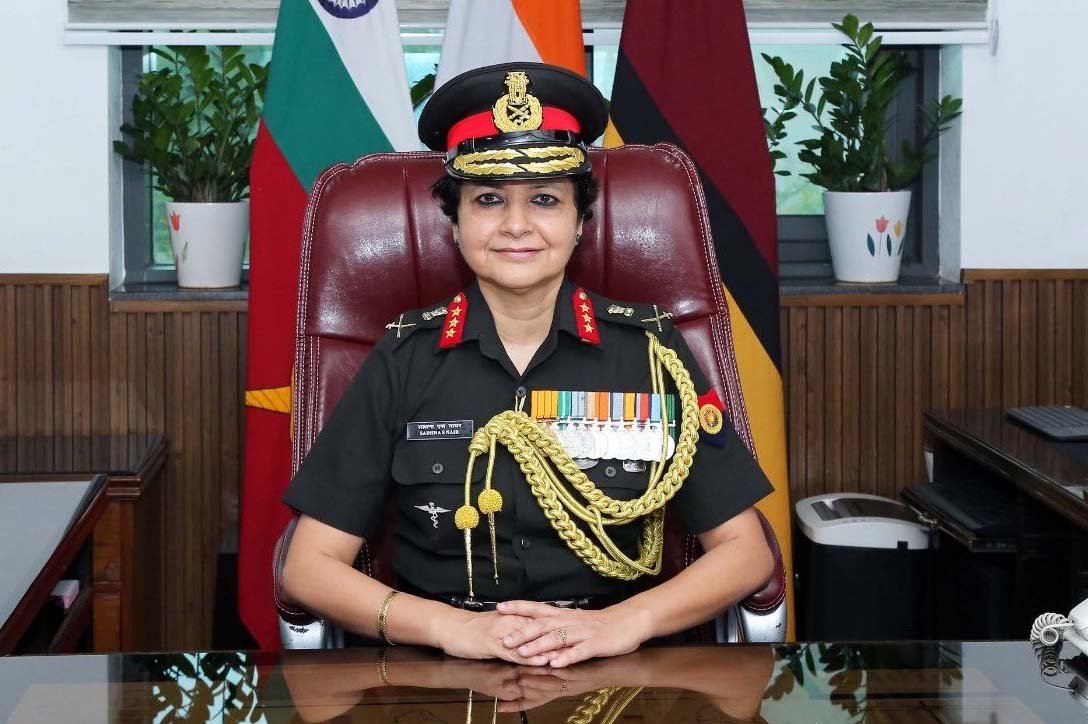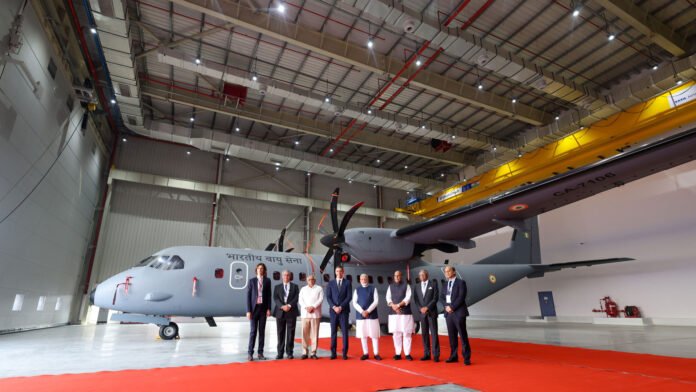India’s ranking as the fourth most powerful military globally, as per the 2024 Global Firepower Index, is a testament to its growing stature in the region. The past year has been marked by substantial reinforcements across all three services in the form of state-of-the-art arms, ammunition, and cutting-edge technologies.
In 2024-25, the government demonstrated a strong commitment to defence modernisation, with a record allocation of ₹6.21 lakh crore to the Ministry of Defence (MoD). This included ₹1.72 lakh crore specifically earmarked for capital outlay, reflecting a 20.33 per cent increase compared to FY 2022-23’s actual expenditure. This significant allocation is intended to bolster the operational capabilities of the Armed Forces.
Indigenous Defence Production and Exports
The MoD achieved unprecedented growth in indigenous defence production, reflecting the successful implementation of government policies. Defence exports reached a record ₹21,083 crore (approximately USD 2.63 billion) in FY 2023-24, marking a 32.5 per cent increase over the previous fiscal year’s ₹15,920 crore. Over the last decade, defence exports have grown 31 times compared to FY 2013-14. The defence industry, comprising both Defence Public Sector Undertakings (DPSUs) and private entities, played a crucial role, with contributions of 40 per cent and 60 per cent, respectively.
Major Defence Milestones and Acquisitions in 2024
The past year was notable for several landmark achievements and acquisitions:
- The establishment of the C-295 Tata Aircraft Complex at Vadodara, Gujarat, for the production of C-295 transport aircraft.
- Successful trials of the Indian Light Tank (ILT) ‘Zorawar’ at altitudes exceeding 4,200 meters and its exceptional performance in desert terrain.
- The commissioning of the second Arihant-Class submarine, INS Arighaat, on August 29, 2024, at Visakhapatnam. The submarine’s construction involved cutting-edge design, advanced manufacturing technologies, and extensive contributions from Indian scientists, industry, and naval personnel.
- The commissioning of INS Tushil (F 70), a stealth-guided missile frigate, in the presence of Defence Minister Rajnath Singh at the Yantar Shipyard in Kaliningrad, Russia on December 9, 2024. This vessel is designed for blue-water operations across air, surface, underwater, and electromagnetic dimensions of naval warfare.
- Completion of the induction of all units of the Light Combat Helicopter (LSP) Prachand in February 2024. These helicopters actively participated in Exercise Gagan Shakti in April 2024.
India’s Navy is set to bolster its capabilities with two nuclear-powered attack submarines, constructed at the Ship Building Centre in Visakhapatnam. This ₹45,000 crore project underscores the shift toward indigenous defence manufacturing
Defence Acquisitions and Approvals
In 2024, the Defence Acquisition Council (DAC) and Defence Procurement Board (DPB) approved 40 capital acquisition proposals worth ₹4,22,129.55 crore. Of this, ₹3,97,584.34 crore (94.19 per cent) was allocated for indigenous procurement. These proposals included a diverse array of modern weaponry, such as future-ready combat vehicles, air defence fire control radars, and medium-range maritime reconnaissance aircraft.
Additionally, in December 2024, the MoD approved capital acquisitions worth over ₹21,772 crore, including water-jet fast attack crafts, advanced light helicopters for coastal surveillance, and next-generation radar warning receivers.

Aatmanirbhar Bharat in Defence
India’s domestic defence production reached a record ₹1.27 lakh crore in 2024, a 16.7 per cent increase over the previous year. Private sector contributions amounted to ₹26,506 crore, accounting for 21 per cent of the total production. Over 14,000 MSMEs and nearly 350 start-ups are now engaged in defence manufacturing in India.
The government has set an ambitious target of achieving ₹3,00,000 crore in annual defence production by 2029, a threefold increase from current levels. Liberalisation of the Foreign Direct Investment (FDI) cap in defence, now at 74 per cent, has attracted ₹5,700 crore in inflows up to 2024.
India has steadily indigenised military capabilities, with platforms like the aircraft carrier INS Vikrant, the frigate INS Sahyadri, and the Tejas Light Combat Aircraft showcasing domestic excellence. Export initiatives, such as the BrahMos missile sale to the Philippines, underline India’s growing footprint in global defence markets.

Focus on Ammunition Procurement
The Indian Army is implementing a long-term ammunition procurement plan to establish indigenous sources for all ammunition types. Currently, 154 of 175 ammunition variants (88 per cent) have been indigenised.
The achievements of 2024 provide a robust foundation for the Armed Forces to further enhance their capabilities. However, the road ahead requires continued innovation and commitment to ensure India’s strategic autonomy and defence leadership in the global arena.
The Cabinet Committee on Security approved the purchase of 31 Predator drones from General Atomics under a landmark India-US deal. These drones promise enhanced surveillance and operational efficiency for the Indian Armed Forces
The Indian Navy is set to receive two nuclear-powered attack submarines, designed to significantly enhance its operational capabilities in the Indian Ocean Region (IOR). The construction of these submarines will take place at the Ship Building Centre in Visakhapatnam, with an estimated cost of ₹45,000 crore. This ambitious project will involve substantial participation from private sector firms, including Larsen and Toubro, reflecting a shift towards indigenous defence production and self-reliance.
In addition to the submarines, the Cabinet Committee on Security has greenlit the procurement of 31 Predator drones from the American firm General Atomics. This acquisition, finalised under a Foreign Military Sales agreement between India and the United States, was time-sensitive, requiring approval before October 31, 2024.
Initiatives Taken to Promote Technology Infusion
The Army Design Bureau (ADB) continues to play a pivotal role in facilitating technological research and development (R&D) efforts and the procurement of indigenously developed weapons and equipment. To complement the Indian government’s vision and create a robust defence ecosystem, the Indian Army is spearheading ‘Make Projects.’ Out of 52 such projects, 35 have reached the prototype development stage or beyond. Furthermore, the number of projects under the Army Technology Board (ATB) has risen from 17 to 62 within a year.
The ADB has mapped over 1,700 industries, engaged with 200+ top academic institutions, and partnered with 50 R&D organisations across India. Its outreach initiatives include forward area tours, internal development trials, capability demonstrations (on a no-cost, no-commitment basis), and access to field firing ranges and equipment. Regional technology nodes have also been established to enhance collaboration.

Digitisation and Automation
The Indian Army’s declaration of 2024 and 2025 as the ‘Years of Technology Absorption’ has placed a strategic focus on modernisation through technological infusion. This involves several initiatives in automation, digitisation, development of joint applications for tri-services, data management, and the integration of artificial intelligence (AI).
The Army has developed 59 new software applications to enhance situational awareness, generate a comprehensive operational and intelligence picture, facilitate human resource management, and create robust management information systems across multiple domains. Collaboration with industry, public sector undertakings (PSUs), academia, and start-ups is being actively pursued. These efforts are aligned with India’s AI Mission, National Quantum Mission, and IT Mission.
An AI roadmap has been prepared, outlining timelines and stakeholder responsibilities for achieving tactical, operational, and strategic goals. Additionally, the Indian Army has signed an agreement with Bharat Electronics Limited (BEL) for joint technology incubation. As part of this initiative, an AI Incubation Centre for the Indian Army will be established at BEL’s R&D centre.
Women officers in the Indian Army have broken new ground with 124 commanding major units and 507 receiving permanent commissions. Lieutenant General Sadhna Saxena Nair’s appointment as DGMS (Army) marks a historic milestone
Increased Tri-Services Synergy
In 2024, formations along the International Border (IB) continued rigorous training to maintain the highest standards of operational readiness in collaboration with other services. Joint amphibious training exercises such as Exercise JAL PRAHAR-I were conducted with the Indian Navy in Visakhapatnam in September 2024. This was followed by Operation Sea Test (OST) of INS Jalashwa at Kakinada in October 2024.
An integrated tri-service live demonstration and static display were conducted on March 12, 2024, with the Indian Army as the lead service. Held at the Pokhran Field Firing Ranges, the exercise aimed to validate joint all-arms, air-land battle strategies in a tri-service setting using indigenous equipment. Approximately 250 types of equipment across domains such as aircraft, ISR platforms, unmanned and counter-unmanned aerial systems, robotics, communication technologies, and cyber applications were showcased.

Military Diplomacy
Reflecting India’s rising global stature, the Indian Army has significantly increased its diplomatic engagements and is now engaged with 118 countries through various defence cooperation activities. Phase 1 of the defence wing reorganisation initiative saw the number of defence wings increase from 45 to 52, with new establishments in Poland, Algeria, Ethiopia, and Mozambique during 2024. Phase 2, which involves setting up four additional defence wings, is currently underway.
The Indian Army participates in 39 joint exercises annually and is planning new bilateral exercises with Egypt, the UAE, Saudi Arabia, and Cambodia. Emphasis on initiatives such as yoga and Nari Shakti is also integrated into these exercises.
From AI-infused solutions to digitisation initiatives, the Indian Armed Forces have embraced the 2024-2025 theme of “Years of Technology Absorption.” With collaborations like AI incubation centres, India aims for operational excellence and futuristic readiness
Nari Shakti and Women Empowerment
Women officers (WOs) are being provided equal opportunities in career courses, foreign exposures, and challenging appointments, aligned with the government’s Nari Shakti programme. Presently, 124 WOs are serving in command appointments, leading major units in challenging assignments. Permanent commissions have been granted to 507 WOs, and their inclusion in the Corps of Artillery has increased their representation across arms and services, except for combat arms. Additionally, nine women have been inducted as Non-Departmental Territorial Army Officers.
On August 1, 2024, Lieutenant General Sadhna Saxena Nair assumed office as DGMS (Army), becoming the first woman to hold this prestigious position.

Moving Forward
The Indian Armed Forces’ shift towards technology absorption raises both expectations and challenges. To ensure operational readiness, integrating advanced tools like drones, AI, and cybersecurity is critical. Additionally, the path to becoming a regional military power in the Indo-Pacific necessitates incremental budget increases to address IAF squadron shortfalls and meet the other services’ needs.
Encouraging greater private-sector participation and initiating collaborative programmes with friendly nations could be game changers. Submarine manufacturing, LCA Mk 2 fighter development, and strides toward 6th generation fighter aircraft are potential areas for such collaboration.
On the whole, the Indian Armed Forces must continue evolving to remain a cohesive, technologically advanced, and operationally ready force capable of addressing current and future challenges effectively.
-The writer is a New Delhi-based senior commentator on international and strategic affairs, environmental issues, an interfaith practitioner, and a media consultant. The views expressed are personal and do not necessarily carry the views of Raksha Anirveda






